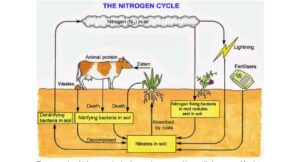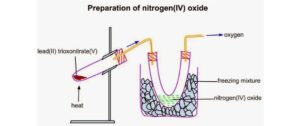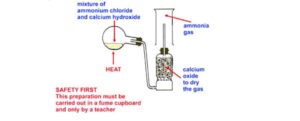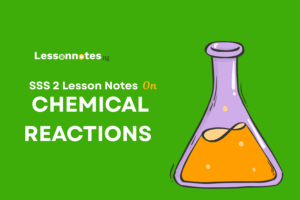Nitrogens SS2 Chemistry Lesson Note
Download Lesson NoteTopic: Nitrogens
GENERAL PROPERTIES OF NITROGEN FAMILY (GROUP VA ELEMENTS)
The group V elements include Nitrogen, Phosphorus, Arsenic, Antimony and Bismuth. There are more differences than similarities between the elements in this group.
Nitrogen is a diatomic gas and does not exhibit allotropy. Phosphorus is a typical non-metal and exhibits allotropy. Arsenic and Antimony are metalloid; while bismuth is a metal.
Nitrogen is a colourless gas. Phosphorus exists in a variety of allotropic forms like white and red phosphorus. Arsenic exists as a dull grey metallic solid. Antimony and bismuth are silvery-white solids.
Nitrogen is the most electronegative element in the group. It combines with metals and non-metals to form a variety of compounds.
ELECTRONIC CONFIGURATION
The electronic configuration of the group V elements is as follows:
Nitrogen = 7: 1s² 2s² 2p³
Phosphorus = 15: 1s² 2s² 2p⁶ 3s² 3p³
Arsenic = 33: 1s² 2s² 2p⁶ 3s² 3p⁶ 3d¹⁰ 4s² 4p³
Antimony = 51: 1s² 2s² 2p⁶ 3s² 3p⁶ 3d¹⁰ 4s² 4p⁶ 4d¹⁰ 5s² 5p³
NITROGEN
Nitrogen occurs chiefly as a free element in the air. It makes up 78% of the volume of the atmosphere. It also exists in combined form in many compounds e.g. ammonia, urea, proteins etc.
LABORATORY PREPARATION
- From Air:
It can be obtained from air by passing air through caustic soda to remove CO2 and overheated copper turnings to remove O2 respectively. The nitrogen obtained is not pure, it contains 1% by volume of rare gases and it is denser than air.
Pure nitrogen is obtained in the laboratory by chemical method. The following chemicals are used to prepare nitrogen.
- Thermal decomposition of ammonium dioxonitrate (III)
- NaNO2(aq) + NH4Cl(aq) → NH4NO2(aq) +NaCl(aq)
- NH4NO2(aq) → 2H2O(l) + N2(g)
- Thermal decomposition of ammonium heptaoxodichromate (VI)
(NH4)2Cr2O7(s) → Cr2O3(s) + 4H2O(l) + N2(g)
2. Oxidation of ammonia by hot Copper (II) oxide
2NH3(g) + 3CuO(s) → 3Cu(s) + 3H2O(g) + N2(g)
- Reduction of dinitrogen (I) oxide by red-hot copper.
N2O(g) + Cu(s) → CuO(s) + N2(g)
INDUSTRIAL PREPARATION
Industrially, nitrogen is obtained by fractional distillation of liquid air.
PHYSICAL PROPERTIES
- It is colourless, odourless and tasteless
- Pure nitrogen is lighter than air.
- Slightly soluble in water
- Melting point – 210°C and boiling point is -196°C
CHEMICAL PROPERTIES
- It reacts with very electropositive metals to form nitrides
3Mg(s) + N2(g) → Mg3N2(s)
- It reacts with non–metals like hydrogen and oxygen to form ammonia and oxides respectively.
N2(g) + 3H2(g) → 3NH3(g)
N2(g) + 2O2(g) → 2N2O(g)
USES
- It is used industrially to manufacture ammonia.
- Liquid nitrogen is used as a cooling agent.
- It is used as a preservative in packaged foods to prevent rancidity.

The stages in which atmospheric nitrogen is converted into soil nitrogen and back to free nitrogen occur in the following ways:
i. Oxidation of atmospheric nitrogen: During lightning and thunderstorms, there is electrical discharge in the atmosphere which causes atmospheric nitrogen and oxygen to combine to form oxides of nitrogen which can dissolve in rainwater as dinitrate (III) and trioxonitrate (V) acids. These acids go into the soil and react with mineral salts in the soil to form trioxonitrate (V) salts which are absorbed by plants.
N2(g) + O2(g) > 2NO(g)
2NO(g) + O2(g) > 2NO2(g)
4NO(g) + O2(g) + 2H2O(l) > 4HNO2(aq)
4NO(g) + O2(g) + 2H2O(l) > 4HNO3(aq)
ii. Action of nitrogen-fixing bacteria: Soil microorganisms like Rhizobium living in root nodules of leguminous plants can convert atmospheric nitrogen into organic nitrogenous compounds which are used directly by the host plants. These compounds are released into the soil when these plants die. Other free-living microorganisms in the soil like Azotobacter and Clostridium are also able to convert atmospheric nitrogen directly into trioxonitrate (V) which is absorbed by plants. These processes are known as nitrogen fixation.
iii. Decay of organic matter: When plants and animals die, putrefying bacteria and fungi in the soil converts organic nitrogenous compounds to ammonia. Nitrifying bacteria like Nitrosomonas and Nitrobacter convert the ammonia to trioxonitrate (V) which can again be absorbed by plants. These processes are known as nitrification.
iv. Denitrification: Trioxonitrate (V) salt in the soil can be converted to gaseous nitrogen by denitrifying bacteria. The process is known as Denitrification. The nitrogen so formed escapes into the atmosphere, where it becomes atmospheric nitrogen. Denitrifying bacteria therefore reduces the quantity of trioxonitrate (V) in the soil.
OXIDES OF NITROGEN
- Nitrogen (I) Oxide, N2o
Nitrogen (I) oxide is known as a laughing gas as it causes uncontrollable laughter when inhaled.

Laboratory Preparation
The gas is prepared in the laboratory by thermal decomposition of ammonium trioxonitrate (V). Ammonium trioxonitrate (V) is not heated directly since the reaction is exothermic and may become uncontrollable leading to an explosion.
a. KNO3(s) + NH4Cl(s) → KCl(s) + NH4NO3(s)
b. NH4NO3(s) → 2H2O(g) + N2O(g)
Physical Properties
- It is a colourless gas with a faint pleasant sickly smell and it has a sweetish taste.
- It is fairly soluble in cold water.
- It is 1.5 times denser than air.
- It is neutral to moist litmus paper.
Chemical Properties
i. It decomposes on strong heating (about 600oC) to form nitrogen and oxygen.
2N2O(g) → O2(g) + 2N2(g)
ii. It supports the combustion of any burning substance which is hot enough to decompose it.
Mg(s) + N2O(g) → MgO(s) +N2(g)
iii. It is reduced to nitrogen by heated copper or iron
Cu(s) + N2O(g) → N2(g) + CuO(s)
Test For N2O
A glowing splint is inserted into the gas jar containing the unknown gas. If the splinter is rekindled, the gas is either oxygen or nitrogen (I) oxide. If the gas has a pleasant smell and does not produce brown fumes with nitrogen (IV) oxide; then the gas is nitrogen (I) oxide.
USE: Nitrogen (I) oxide is used as an anaesthetic for minor surgical operations.
- Nitrogen (Ii) Oxide, NO
Laboratory Preparation
Nitrogen (II) oxide is prepared by reacting 50% trioxonitrate (IV) acid with copper.
3Cu(s) + 8HNO3(aq) → 3Cu(NO3)2(aq) + 4H2O(l) + 2NO(g)
Some of the nitrogen (II) oxide gas reacts with oxygen in the flask to form brown fumes of nitrogen (IV) oxide which is dissolved in water as the gas is passed through water.
Physical Properties
- It is a colourless and poisonous gas.
- It is almost insoluble in water.
- It is slightly denser than air.
- It is neutral to litmus.
Chemical Properties
i. It reacts readily with oxygen to form brown fumes of nitrogen (IV) oxide
2NO(g) + O2(g) → 2NO2(g)
ii. It decomposes on heating at high temperatures to form an equal volume of nitrogen and oxygen
2NO(s)→ N2(g) + O2(g)
iii. It is reduced to nitrogen by hot metals
2Cu(s) + 2NO(g) → 2CuO(g) + N2(g)
iv. It acts as a reducing agent decolourizing acidified potassium tetraoxomanganate (VI) slowly
3MnO4-(aq) + 4H+(aq) + 5NO(g) → 3Mn2+(aq) + 5NO3-(aq) + 2H2O(l)
Test For NO
i. Using air: the gas jar containing the unknown gas is opened, if the gas turns reddish-brown, then the gas is NO.
ii. Using iron (II) tetraoxosulphate (VI): A solution of FeSO4 which has been acidified with a little dilute H2SO4 acid is poured into the gas jar containing the unknown gas. If the solution turns dark brown, then the gas is NO.
- Nitrogen (Iv) Oxide, NO2
Laboratory Preparation
Nitrogen (IV) oxide is prepared by the thermal decomposition of lead (II) trioxonitrate (V) because the nitrate does not contain water for crystallization which can interfere with the preparation.
Pb(NO3)2(s) → 2PbO(s) + O2(g) + 4NO2(g)
The gas mixture obtained is passed through a U-tube immersed in a freezing mixture. Nitrogen (IV) oxide liquefies as a green liquid (yellow if pure) in the tube while oxygen escapes out.

Physical Properties
- It is a reddish–brown gas.
- It has an irritating smell and is poisonous.
- It turns damp blue litmus paper red and dissolves in water to form an acidic solution.
- iv It liquefies into a yellow liquid at 21oC.
- It is much heavier than air.
Chemical Properties
i. Nitrogen (IV) oxide exists mainly as dinitrogen (IV) oxide, N2O4 at low temperatures. It decomposes on heating as follows.
N2O4(g) > 2NO2(g) > 2NO(g) + O2(g)
ii. It supports combustion as it decomposes on heating to nitrogen and oxygen
2NO2(g) → N2(g) + 2O2(g)
iii. It is reduced to nitrogen by a reducing agent.
4CU(s) + 2NO(g) → 4CuO(s) + N2(g)
iv. It dissolves in water to form a mixture of dioxonitrate (III) and trioxonitrate (V) acids. It is a mixed acid anhydride.
H2O(l) + 2NO2(g) → HNO2(aq) + HNO3(aq)
v. It reacts with alkalis to form a mixture of dioxonitrate (III) and trioxonitrate (V) salts
2KOH(aq) + 2NO2(g) → KNO3(aq) + KNO2(aq) + H2O(l)
- Ammonia
Ammonia is a hydride of nitrogen. It is produced in nature when nitrogenous matter decays in the absence of air. Thus, traces of ammonia may be found in the atmosphere but being very soluble in water, it is dissolved by rainwater and washed down into the soil.

Laboratory Preparation Of Ammonia
- Ammonia is prepared in the laboratory by heating calcium hydroxide, Ca(OH)2 (slaked lime) with ammonium chloride.
Ca(OH)2(s)+ 2NH4Cl(s) → CaCl2(s) +2H2O(l)+2NH3(g).
- Ammonia is dried using calcium oxide, and CaO. Ammonia being alkaline cannot be dried using Conc. H2SO4 or fused CaCl2, because they will react.
Industrial Preparation
Ammonia is manufactured from nitrogen and hydrogen by the Haber process. It involves mixing nitrogen and hydrogen in a ratio of 1:3 by volume. The reaction is reversible so special conditions listed below are required for optional yield of ammonia.
A finely divided iron catalyst is used
A temperature of about 450°c is used
A pressure of about 200 atm is used.
The yield is about 15% under this condition
N2(g) +3H2(g) 2NH3(g) + heat
Physical Properties
- It is a colourless gas with a characteristic choking smell.
- Ammonia in large quantities is poisonous as it affects respiratory muscles.
- It is the only known alkaline gas.
- It is about 1.7 times less dense than air.
- Solid ammonia melts at -34.4OC and the liquid boils at -77.7OC.
Chemical Properties
i. Ammonia burns readily in oxygen to form water vapour and nitrogen
4NH3(g) + 3O2(g) → 6H2O(g) + 2N2(g)
ii. Ammonia reacts as reducing agents reacting with
a. Copper II oxide
3CuO(s) + 2NH3(g) → 3Cu(s) + 3H2O(l) + N2(g)
b. Chlorine
3Cl2(g) + 8NH3(g) → 6NH4Cl(s) + N2(g)
iii. Ammonia reacts with carbon IV oxide to form Urea and water vapour.
2NH3(g) + CO2(g) → (NH2)2 CO(s) + H2O(l)
iv. Ammonia reacts with acid to form ammonium salts.
2NH3(g) + H2SO4(g) → (NH4)2SO4(s)
Test For Ammonia
- Ammonia has a choking smell. It can be confirmed using:
- Litmus paper: Damped red litmus is dipped into the gas jar containing the unknown gas. If the litmus paper turns blue, then the gas is ammonia.
- Hydrochloric acid: a glass rod is dipped in concentrated HCl and then inserted in the gas jar containing the unknown gas. If white fumes are observed on the glass rod, then the gas is ammonia.
Uses Of Ammonia
- Ammonia is used in the manufacture of trioxonitrate (V) acid and Sodium trioxocarbonate (IV) by the Solvay process.
- Liquid ammonia is used as a refrigerant.
- Aqueous ammonia is used in softening temporary hard water.
- Aqueous ammonia is also used in laundries as a solvent for removing grease and oil stains.
- Trioxonitrate (V) Acid, HNO3
Laboratory Preparation
Trioxonitrate (V) acid is a volatile acid and it is prepared in the laboratory by its displacement from any trioxonitrate salt by concentrated H2SO4 which is less volatile. Trioxonitrate (V) of potassium or sodium is usually used because they are cheap.
KNO3(s) + H2SO4(aq) → KHSO4(aq) + HNO3(aq)
NOTE: An all-glass apparatus must be used in this preparation because the hydrogen trioxonitrate (V) acid vapour will attack the cork or rubber.

Industrial Preparation
Trioxonitrate (V) acid is obtained by the catalytic oxidation of ammonia:
i. Ammonia is treated with excess air using a Platinum-rhodium catalyst at 700oC to produce nitrogen (II) oxide (96% conversion of NH3 is obtained)
4NH3(g) + 5O2(g) → 4NO(g) + 6H2O(g)
ii. Nitrogen (II) oxide is cooled and mixed with excess air to produce nitrogen (IV) oxide.
2NO(g) + O2(g) → 2NO2(g)
iii. Nitrogen (IV) oxide is dissolved with excess air in hot water to yield a trioxonitrate (V) acid solution of up to 50% concentration.
4NO2(g) + 2H2O(l) + O2(g) → 4HNO3(aq)
Physical Properties
i. pure acid is a colourless fuming liquid with a sharp choking smell. The acid turns yellow due to its decomposition to nitrogen (IV) oxide which redissolves in the acid.
ii. The pure acid boils at 860C and melts at -47oC
iii. The density of the pure acid is 1.52 cm-3
iv. The pure acid is miscible with water in all properties and forms a constant boiling mixture with it at 121oC
v. The concentrated form of the acid is corrosive.
vi. The dilute acid turns blue litmus red.
Chemical Properties
i. As an acid it neutralizes bases and alkalis to form metallic trioxonitrate (V) and water only
NaOH(aq) + HNO3(aq) → NaNO3(aq) + H2O(l)
ii. As an acid it reacts with metallic trioxocarbonate (IV) to liberate carbon (II) oxide
CaCO3(s) + HNO3(aq) → Ca(NO3)2(aq) + H2O(l) + CO2(g)
iii. Unlike other acids, it rarely gives out hydrogen with metals except when a very dilute solution is reacted with Ca, Mg or Mn.
iv. As an oxidizing agent, it reacts with the non–metal to form the corresponding oxides of the non–metals.
S(s) + 6HNO3(aq) → H2SO4(aq) + 2H2O(l) + 6NO2(g)
v. As an oxidizing agent, it oxidizes Cu, Pb, Hg and Ag to yield the respective trioxonitrate (V) and nitrogen (IV) oxide if concentrated, but nitrogen (II) oxide if the concentration is moderate.
vi. Aluminum and iron are not oxidized to their oxides by concentrated HNO3(aq) due to the formation of a surface coating of oxide which is passive and does not allow further reaction with the metals. Aluminium or iron-lined container can be used to transport concentrated HNO3(aq)
vii. As an oxidizing agent, it oxidizes hydrogen sulphide to sulphur
H2S(g) + 2HNO3(aq) → S(s) + 2H2O(l) + 2NO2(g)
viii. As an oxidizing agent, it oxidizes iron (II) salts to iron (III) salts
6Fe2+(aq) + 8H+(aq) + 2NO3-(aq) → 6Fe3+(aq) + 4H2O(l) + 2NO(g)
Uses
i. It is used as an acid, oxidizing agent and nitrating agent in the laboratory.
ii. It is used in nylon production and Terylene.
iii. It is used as rocket fuel.
iv. It is used in the production of fertilizers, dyes, drugs and explosives.






















